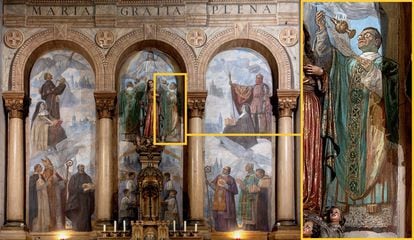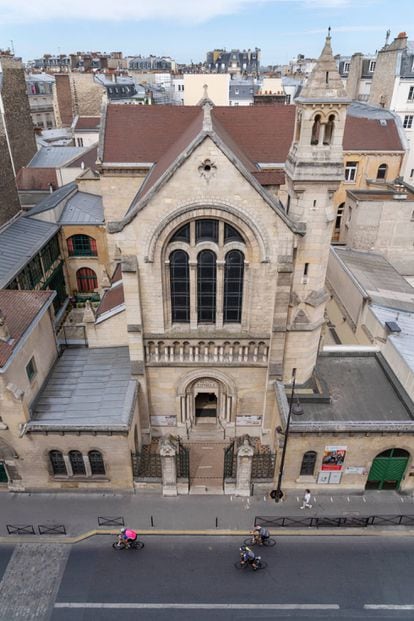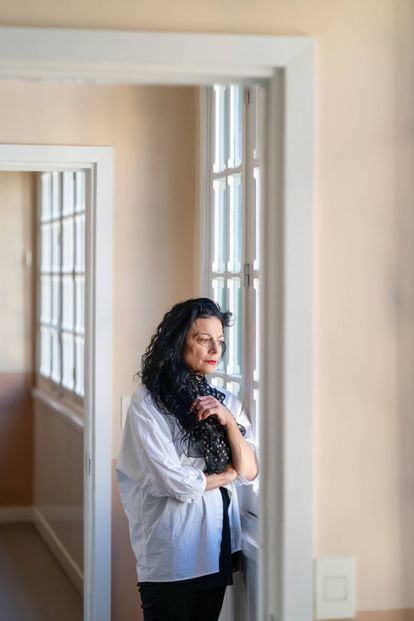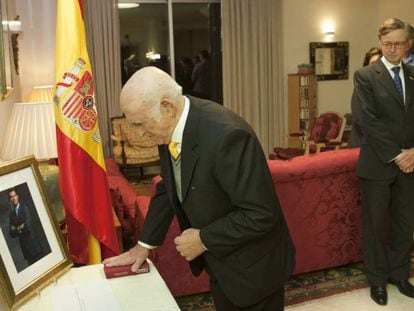The forgers of God
Four Spanish Claretian priests put themselves at risk to try to save 155 Jews from Nazi persecution between 1940 and 1944 in Paris. During that period, fake baptisms were carried out in a clandestine operation that was kept strictly under wraps; until now
/cloudfront-eu-central-1.images.arcpublishing.com/prisa/FMZINZWSWJHAJGGBN4G2MMVPGQ.jpg)
For 80 years, a small Spanish community of Claretian missionaries in Paris has not breathed a word about their bid to save 155 Jews during the Nazi occupation of France between 1940 and 1944.
At number 51 bis, on the narrow Rue de la Pompe, just half an hour’s walk from the Eiffel Tower, the Claretian Mission has been hiding hundreds of fake christening certificates that four of its priests drew up and signed in order to prevent the pro-Nazi Vichy French government from arresting dozens of Jewish families.
These musty “Christian” identity documents, tucked away in a tiny closet, bear witness to the fact that Gilberto Valtierra, Joaquín Aller, Emilio Martín and Ignacio Turrillas put their lives on the line to take in these Jewish families, facilitate their flight from France, and shield them from the frequent deportations to concentration and extermination camps. Only now has their secret come to light.
So many years after the events, there are no witnesses bar the stone walls and the intricate passageways that connect the parish with the monastery. But crossing the wide nave of the parish and observing the statue of Saint John of the Cross or searching through books in the library, it is impossible not to wonder about the steps those Jewish families had to take in order to obtain protection against persecution. Did they enter through the small green side door on the side that gives directly onto the monastery? Did they do so at night? Did they sign the fake documents on the large wooden table in the sacristy? Or did they hide in the crypt chapel? When these questions are put to those living on the premises today, the answer is always the same: “We don’t know. Everyone around at that time has passed away.” So how to piece the story together and rescue it from oblivion?
It was a mere snippet of information exchanged in a cafeteria in central Paris in 2018 that led 26-year-old historian and professor at the University of Extremadura, Santiago López Rodríguez, to investigate what really happened in that church run by the Spanish Claretians during the war. “I was researching Spanish diplomacy during the Holocaust for my doctoral thesis in the consulate archive and doing interviews with survivors and relatives of the victims of the Nazi extermination,” he explains. “While I was having coffee with Alain de Toledo, the son of a deportee from the Royallieu-Compiègne camp, he told me that his parents had had their baptismal certificates forged in a Spanish church in Paris to help them flee to Spain.” Toledo offered no further details but López Rodríguez decided to follow the lead and headed for Rue de la Pompe.

López knocked at the door of the mission and was greeted by a Claretian with a Burgos accent called Carlos Tobes Arrabal. Tobes led López along a passageway to the small closet where the baptism certificates are kept. In an adjacent office, López inspected each certificate – all registered between 1940 and 1944 – under the watchful eye of the Virgin Fatima. Written in blue and black ink were dozens of Jewish surnames – the names of people who had been born abroad, most of them in Thessaloniki, Greece and Istanbul, Turkey. “It is clear how the number of baptisms in the parish soared by 200% during this time,” says López. “Entire families were converted on the same day, and in some cases, marriage certificates [22 in total] were also forged.”
The 155 forgeries happened over a period of five years, between October 3, 1940 and July 12, 1944. There are four in 1940, 68 in 1941, 30 in 1942, 45 in 1943 and eight in 1944 as the Nazi occupation of France came to an end.
There is no clue as to whether Father Valtierra used holy water to baptize them or whether he simply took them to an office to sign the documents
After dusting off the volumes and deciphering the handwriting of all the signatories, López cross-referenced the mission’s data with what he found in other French archives and found that up to 60 of these documents corresponded to Jews who were registered as Spanish while 19 corresponded to people who had the protection of the consulate. This discovery has now been woven into López’s doctoral thesis The Spanish Foreign Service during the Holocaust in occupied France (1940-1944), which he hopes to publish in the coming months.
The Modiano family was the first to be baptized. Maurizio Modiano, 65, his wife Eda Maria, 51, his son Rene, 20, and his niece Maria Francisca Hasson, nine, lived at 134 Avenue de Malakoff. Except for María Francisca, they were all born in Thessaloniki, Greece. There is no clue as to whether Father Valtierra, the priest who signed the documents, used holy water to baptize them or whether he simply took them to an office to sign the documents. What does appear on their records is the date, October 3, 1940, the day that the Statutes on Jews came into force; in other words, the anti-Semitic laws signed by the Vichy leader Philippe Pétain that ushered in a census of the Jews living in France and led to their deportations to concentration and extermination camps. It is estimated that more than 75,000 Jews were killed on account of these laws and the point of these forged certificates was, according to López, to trick the authorities into believing that a conversion to Catholicism had taken place in a bid to save these 155 Jews from the same fate.
In clear handwriting, the priests took turns forging the documents and recording relevant data, which, when analyzed now, allows us a glimpse of who those being baptized were. Almost all were Sephardic Jews – the collective that had been driven out of Spain in the 15th century – and the average age was 33, with the youngest being just a few months old, and the oldest, 75. Almost all were given a Spanish name so that when they presented their documentation to the French authorities, they would not be linked to names registered on the Jewish census; Levy, for example, became Luis, Jacob became Jaime and Moses became Mauricio.
It is also interesting to see how some, weeks after being “baptized”, appear as godparents to other Jews in the records. The Modiano couple, for example, are recorded as being the godparents on the baptismal certificate of 20-year-old Victor Gomerzano, who had been born in Constantinople – today’s Istanbul. This suggests that, in many cases, those being baptized were related to one another and the Claretians’ secret spread among them by word of mouth.
Four priests at war with the anti-Semitic laws
Helping Jews during that time in France was considered a serious crime, especially any forging of documents such as visas, passports or baptism certificates. “These priests were not only breaking Church law by undertaking fake conversions, they were also taking a stand against the French state,” López explains as he reviews the Claretian archive in search of anything that might shed more light on what happened. “If this had been exposed, it would have undoubtedly meant their expulsion from France and a huge blow to Spanish diplomacy.”
So who were these four priests and how did they manage to weave their network of salvation?
When it comes to hard evidence, little more than a dozen photographs remain of these men, stored in a cardboard box at the Rue de la Pompe mission. But there are those who recall having heard stories about them.
Apparently, they lived in the mission together with another 10 Claretians, though they appeared to carry a remarkable amount of weight within the brotherhood. In the fresco above the parish altar, there is a portrait of a priest that, after comparing his face with other portraits and corroborating the evidence with Father Tobes, is clearly meant to be Father Joaquín Aller.
Born in 1897 in Campo de Villavidel in León, Aller was then at the head of the Claretians. The local Asturian press at the time reported that he had collaborated with an exiled Asturian communist to return the carving of the Virgin Covadonga to Asturias, after it had spent part of the Civil War in the Spanish Embassy in Paris. He died in Bilbao in 1964.

Little more is known about the others. Gilberto Valtierra was born in 1889 in San Martín de Humada in Burgos, a village of 22 inhabitants. He had a family of five brothers, three of whom became Claretians. His great-nephew, Luis Porras Valtierra, still lives in San Martín de Humada. “What do you mean? Did that really happen?” asks the nephew when he receives a call from López. “The truth is that he was a good man. I remember that he once came to the village to see my mother. But, as far as I know, he never said anything about what you’re telling me.” Referring to his great uncle’s death, he adds: “It was November 1, 1953. A few days later we received a letter from France. In it, a family we’d never heard of told us: ‘The poor of Paris are crying at the grave of Father Valtierra.’ I’ve never forgotten that.”
Emilio Martín, meanwhile, was one of the founding fathers of the Claretian mission in Paris. He arrived there around 1913 with the aim of helping struggling Spanish immigrants. Born in Segovia in 1869, Martín taught and directed the Claretian brothers at Rue de la Pompe until his death in 1951. Now, as you enter the sacristy, there is a charcoal portrait of him on the left.
Tobes, who is the current director of the mission, knew only one of the priests: Ignacio Turrillas, who was born in Monreal, Navarre, in 1897. Tobes nursed Turrillas in his last years. “He was the only one of the four still alive and he died in my arms in 1979,” says Tobes. “He never mentioned anything about this. But one day, years after his death, back in 2008, a woman came to the door saying, ‘I have come to thank you. You saved my parents’ lives.’ No one knew what she meant and we took her to Father Miguel Ángel Chueca, our superior at the time.”
When the woman had gone, Chueca told the missionaries the story, though not in any great detail, and asked them to keep quiet about it. “I think it was a story that the order kept to themselves,” says Tobes. “Now, knowing more about what our brothers did, it fills us with pride and happiness.”
More than a century after it was established, the mission continues to reach out to those in need. The priests teach French to Spanish-speaking immigrants and provide free social services. But there are few brothers left. Compared to the 20 Claretians in the 1940s, there are now just three. Besides Tobes, the mission is home to Father Tomás Tobes Agraz and Father Arturo Pinacho. “The calling never goes,” says a smiling Father Tomás, 81. “We have to serve because many people are in need.” As they eat a modest stew and drink water colored by a squirt of cheap wine, the three priests talk about the great need so many people find themselves in.

Consul Bernardo Rolland
No one yet knows why Father Chueca was reluctant to make such a discovery public; why he was still insisting on secrecy when De Toledo went in search of the evidence proving his parents had been “baptized” at the mission. “He gave no reason,” says De Toledo. “I would have liked to have paid tribute to the mission, but he didn’t want me to.”
This blanket of secrecy was also respected by the majority of those the Claretians helped. For example, De Toledo’s parents never breathed a word of the episode to him. He only found out about the Claretians’ role in saving Jewish lives when he was investigating how the Spanish Consul General in Paris at the time, Bernardo Rolland, known for saving more than 80 Jews, freed his father from the Royallieu-Compiègne concentration camp in 1942 and then helped both his parents into exile in Spain in 1943.
“A cousin of my mother’s, Enrique Saporta y Beja, knew the consul very well,” says De Toledo. “He had lent him an office at the consulate to help the Sephardim. He told me that Rolland was the one who advised these Jews to go and see the priests [to forge the certificates].”
The role of Rolland as a link between those being persecuted and the priests indicates that he participated in the rescue of a hundred more Jews than was previously thought, and that he possibly involved workers from the Official Chamber of Commerce in Paris, who feature as godparents on some of the forged baptism documents. “Without him, my parents would not have survived and I would not have been born,” says De Toledo, who is also president of Muestros Dezaparecidos – Disappeared Evidence – an association that works to recover the historical memory of Sephardic Jews during the Holocaust. “That is why I have been trying for 15 years to get him awarded the Righteous Among the Nations medal. But as far as I’m concerned, without or with it, he is one of the Righteous.”
Unanswered questions
Unraveling the story of the forgers of God, one question remains: how did the French authorities not suspect anything, given these documents contained Jewish surnames and, in many cases, a mature baptism age? Did these baptisms really help to save the lives of most of these families?
López is convinced. “These documents were the perfect way of concealing their faith and giving more credibility to their Spanish nationality certificates or other papers issued by Rolland,” he says. Accredited by the Church, the baptism certificates could get them off the Jewish census that the authorities later used to make thousands of arrests and deportations to concentration and extermination camps. And, as López points out, they increased the chances of getting a visa to leave France. Moreover, although forgery to save Jews was not particularly common, similar episodes involving the rescue of thousands of people from murder at the hands of the Nazis have surfaced. One example was Operation Baptism, in which Cardinal Angelo Giuseppe Roncalli, who became Pope John XXIII between 1958 until 1963, forged baptismal certificates during World War II to save 24,000 Jews in Istanbul, Turkey.
In the case of the Claretians, while 138 Jews helped by the priests managed to escape the Nazis, the forged certificate was not enough to save eight-year-old Rogelio Samuel Benarrosch and 16 others from death in the concentration camps.

On a number of occasions, the Claretians’ activities caused disquiet among the upper echelons of the Church in France. In correspondence between Archbishop of Paris Emmanuel Suhard and the superior of the Claretians, the superior was asked to go to the episcopal headquarters to explain the baptisms. A letter dated February 12, 1942, from Suhard insists: “I told you, the last time I saw you, that the Archbishop’s Council needed an explanation about another Israeli convert whose documentation has not reached us. It concerns Mme. Saporta, who would have been baptized and married in haste in the Spanish chapel. I would be grateful if you would come to see me on Saturday morning, February 14 at 10am sharp, and give me any documentation you have on the matter.”
It is common knowledge that the Archbishop of Paris was opposed to the Vichy Government and to the deportations, so it is reasonable to think that the intention behind these letters was to warn the mission to be careful and to hand over some kind of documentation that would endorse the urgency of these conversions so as not to raise suspicions within the French Church, which supported Hitler. However, no evidence has been found concerning the Archbishop’s position on the forgeries. The current superiors of the order in Spain, who were also unaware of the actions of their brothers in Paris, claim that the forgeries were probably carried out in the strictest secrecy. “The years have passed and it is probable that if other brothers or superiors of the congregation knew of these actions, they would take them to the grave,” says a Claretian spokesman in Madrid.
Among the faded papers that the mission still has from that time, there is a copy of another letter that Father Valtierra wrote to justify the baptism of the Sevi family – Alberto, Matilde and their children Jacqueline and Claudio. “I have no reason to doubt Mr Sevi’s good faith about his conversion,” wrote the priest. “Now he behaves like a Christian, he comes every Sunday to Mass [...].”
Clearly, Valtierra lied to protect the family. Proof of this is found in the archives of Yad Vashem, the official Israeli institution set up in memory of the victims of the Holocaust. There, it is recorded that years after being baptized Albeto and Matilde Sevi handed their daughter over to their neighbors, the Saulniers, a Catholic couple, for protection. “They were not afraid of the bombings, but of being arrested and deported because they were Jews,” the text says. Fortunately, we know that the little girl was reunited with her parents after the war.
More than 100 names, more than 100 stories
Finding and interviewing the protagonists of the top-secret mission is very complex, especially since so many have passed on. After an intensive search of family blogs and family trees, plus more than 500 phone calls, around 20 descendants have been located. Interestingly, none of them knew anything about the Claretians’ role in their lives.
“I’m getting goosebumps. I can’t believe it,” says Karine Saporta, daughter, niece and granddaughter of those who were baptized. “It’s like you’re telling me about someone I don’t know. I don’t understand why they never told me anything.” She heard the news after returning a missed call on her cellphone from the author of this article. “I thought it was a joke,” she adds.
The Saporta case is particularly noteworthy because the youngest member of the family was called Raimundo. He was 16 years old at the time of his conversion and would go on to become the vice-president of Real Madrid. Not only was he Santiago Bernabéu’s right-hand man, he also persuaded one of the world’s greatest players, Alfredo Di Stéfano, to join Real Madrid while managing at the same time to be involved in the International Basketball Federation.

Raimundo’s brother Marcelo, who was Karine’s father, was 19 when the forged baptism certificate aided him in his flight to Madrid. After the war, Marcelo changed his name to Marc and returned to Paris to become an important translator and editor as well as a close friend of Jean-Paul Sartre. The entire family, like many others like them, concealed what had happened from their relatives and took the secret of the Claretians to the grave.
A year after hanging up the phone, Karine visits the mission in Paris to take a look at the famous documents for herself. Accompanied by Father Tobes, she climbs the wooden stairs leading to the library at the top of the monastery. Between two book-lined walls is a table with an open volume lying on it. Karine’s knees are trembling and when she sees her parents’ names, gasps. “Here they are,” she says.
She learned that her parents were also married there in 1949. Father Valtierra, the priest who signed their fake baptism certificate, conducted the wedding ceremony. “I can’t begin to imagine the suffering that my family was subjected to. It’s a story that people should know about. It must be told,” Karine tells Father Tobes.
The Toledo File
For Eliazer Carasso, his wife, Matilde Amarigio, and daughter Alegra, the escape from the Nazis did not end with their flight from France. In fact, the journey to their new home in Casablanca, Morocco, would take almost another year to complete.
As was the norm, the Franco regime distributed the Jewish exiles among a number of Spanish cities while they waited for their respective visas and the Carasso family were sent to Toledo. Six other Jewish exiles joined them in the capital of Castile-La Mancha, among them Edith María Esther Nahamías, who had also been helped by the Claretians. The details of their journey can be found in a police file in the Provincial Historical Archive of Toledo.
Both hand-written and typed by the civil governor of the province of Toledo, the documents specify the accommodation the exiles would use from August 1943 until their departure in December of that same year. The Carasso family lived with a local family at number 2, Escalerilla de la Magdalena street. Justa Córdoba, then 13 years old, still remembers the exiles as “educated people” who were “well dressed” but that “they only talked among themselves.” The years have passed and for Córdoba, now in her 90s, the memories are fading. “I was very young,” she says. “In the neighborhood, it was said that they were Jews that Franco had taken in as refugees.”

In December, the Carasso family managed to take a boat from Málaga to Casablanca. A month earlier, Nahamías was able to secure a safe passage to Barcelona where she was reunited with her husband, Jacob Faraggi. The couple settled in Madrid not long afterward and opened a fashion boutique near the Plaza de la Independencia. According to Anne-Marie Rychner Faraggi, who was related to both, they returned to France in 1945. “They went back after the Second World War,” she says. “Our family doesn’t know much more about them.”
Each name has a story behind it that helps to shed light on one of the blackest periods of the 20th century. But despite the Claretians’ secret coming out into the open, much of the detail remains a mystery. For example, did they take the initiative to save these people or was it the consul who knocked on their door asking for help? Did the bishop agree with their actions or was he simply unaware of what was really going on? And were the Claretians’ forgeries the key to keeping most of the baptized from being killed by the Nazis?
After analyzing the certificates, the letters and the other reports over and again, there is no doubt that the Spanish missionaries at Rue de la Pompe exposed themselves to great risk from the Nazi authorities – but, as their unerring calligraphy reflects, they did so with a steady hand.
English version by Heather Galloway.

